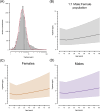Baseline Serum Tryptase: Sex- and Age-Specific Reference Intervals in the Pediatric and Adult Population
- PMID: 40990097
- PMCID: PMC12590325
- DOI: 10.1111/all.70069
Baseline Serum Tryptase: Sex- and Age-Specific Reference Intervals in the Pediatric and Adult Population
Keywords: age; biomarker; elderly; hereditary alpha‐tryptasemia; mast cell disorders; pediatrics; reference intervals; sex; tryptase.
Conflict of interest statement
Y. Chantran serves on the scientific advisory board for Thermo Fisher Scientific, received honoraria from Thermo Fisher Scientific, and research grants from Blueprint Medicines and Thermo Fisher Scientific. M. Michel received honoraria from Thermo Fisher Scientific. J. Vitte reports speaker and consultancy fees in the past 5 years from Astra Zeneca, HpVac, L'Oréal, Novartis, Sanofi, Thermo Fisher Scientific, Zambon, and travel support from Stallergènes‐Greer, outside the submitted work. C. Klingebiel received honoraria from Thermo Fisher Scientific. J.G. reports speaker and travel support in the past 5 years from ALK, Stallergenes‐Greer, Thermo Fisher Scientific, and Menarini, outside the submitted work. Éric Fromentin—ALK‐Abelló, Menarini, Stallergenes Greer, Thermo Fisher, and Viatris. The other authors declare that they have no relevant conflicts of interest.
Figures


References
Publication types
LinkOut - more resources
Full Text Sources

